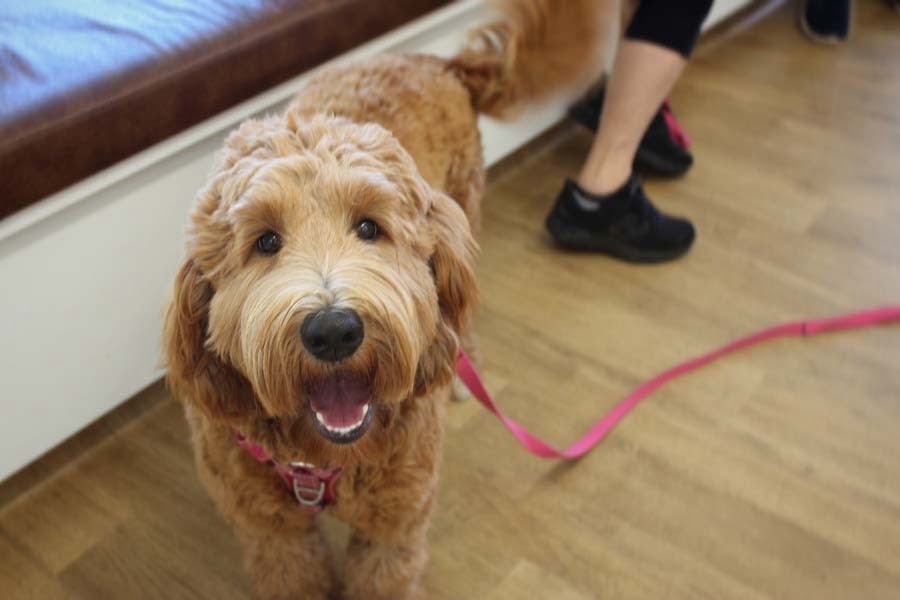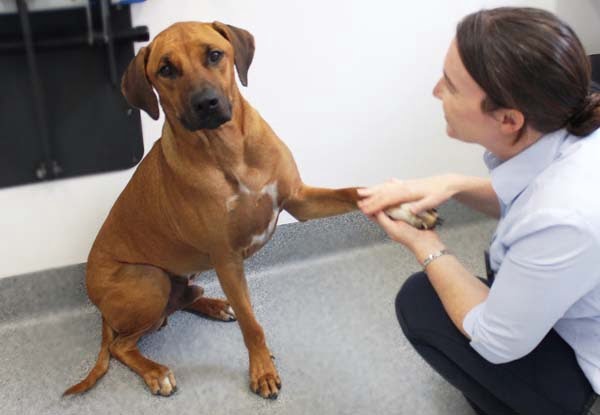A Turramurra Vet Pet Behaviour Article
Creating Fear Free Veterinary Visits for your Dog or Cat

Yay! Let’s Go to the Vet! Creating Fear Free Veterinary Visits for your Dog or Cat
by Katie Bedrossian, Pet Behaviour Consultant
Our aim in veterinary care is to provide for your beloved pet’s health needs – including their mental health!
We want to ensure that your dog or cat enters the veterinary hospital feeling relaxed and maintains a positive outlook throughout their visit to our practice.
While we can’t always avoid all stress in a veterinary hospital environment (as unfortunately injury and illness can be stressful on its own), we can reduce the stress caused by elements of the experience we can control.
Read below for 5 key things you can start now for a fear free vet visit for your pet:
- Introduce mat training. Then ensure the mat comes with you for the vet visit (use it in the car, the waiting room, the exam room and on the table).
This is suitable for both dogs and cats. Mat training is associating positive experiences with a portable mat (not their bed). The mat should be easily rolled or folded and ideally non-slip. It is also about associating the mat with calm, relaxed behaviour such as sitting, lying down, standing quietly or settling. This is best done by having the mat out at home and utilising it for meal times (feed your pet on it), and training sessions. Give plenty of treats to your pet while on their mat!Rewarding your pet whenever they go on the mat voluntarily can help fast-track your progress. Avoid washing your pet’s mat prior to a scheduled vet visit. - To arrive with your pet stress free, focus on a positive travel experience. This involves getting your pet comfortable with their crate or car harness at home as well as within a moving car.
We can do this by placing the crate in a main living area of the home with the door off. This gives them choice of entry/exit which reduces stress. They can also add their own scents. If you have already introduced mat training, you could place the mat in the crate. We can increase the positive association by feeding meals in the crate and putting items of value to your pet in the crate (toys, comfort items). As your pet becomes comfortable, we can start to close the door, gradually increasing time and giving treats, before placing the crate in the car while still and then when moving. Car harnesses can be introduced by feeding high value treats while putting it on and playing a fun supervised game with toys or treats while your dog is wearing it. Ensure you also introduce short periods of time with your dog in the harness secured in the car. - If your pet can have food for their visit, bring your pet’s favourite treats with you – particularly if your pet has allergies or sensitivities.
Treats can be given once at the vet hospital in areas where other animals will not encroach into your pet’s space, such as a quiet waiting room, to get onto the scales, or in the consultation itself. This way we can avoid using physical pressure, such as from hands or a lead, to move your pet, which may lead to stress and resistance.
%27%20fill-opacity%3D%27.5%27%3E%3Cellipse%20fill%3D%22%23000004%22%20fill-opacity%3D%22.5%22%20rx%3D%221%22%20ry%3D%221%22%20transform%3D%22matrix(-143.30807%20-10.55452%2020.19152%20-274.15813%2088.2%2061.2)%22%2F%3E%3Cellipse%20fill%3D%22%23bec1b0%22%20fill-opacity%3D%22.5%22%20rx%3D%221%22%20ry%3D%221%22%20transform%3D%22matrix(2.2092%20-225.24239%20162.97484%201.59848%20438.1%20263.2)%22%2F%3E%3Cpath%20fill%3D%22%239fb13c%22%20fill-opacity%3D%22.5%22%20d%3D%22M558.5%20149l126.8%2034-46.1%20172-126.8-34z%22%2F%3E%3Cellipse%20fill%3D%22%234b4b4c%22%20fill-opacity%3D%22.5%22%20rx%3D%221%22%20ry%3D%221%22%20transform%3D%22matrix(85.09738%2034.38157%20-150.09625%20371.50125%20101%20347.9)%22%2F%3E%3C%2Fg%3E%3C%2Fsvg%3E) Little Lily getting treats during her Canine Behaviour consultation with Katie Bedrossian.
Little Lily getting treats during her Canine Behaviour consultation with Katie Bedrossian.
Treating our pets to reward calm behaviour promotes positive feelings and is useful when getting them used to veterinary visits. - It is okay to talk to your pet, massage, and stroke them while they are at the vet to reassure them – in fact we encourage it!
Remember to keep in check how you are feeling and whether any anxiety or stress from yourself is coming across in your voice or your interaction with your pet. Is your voice speeding up, becoming higher pitched, or are you holding your pet more tightly than usual?The most reassuring touch is slow massage and stroking on areas your dog or cat thoroughly enjoys at home (examples include chest, rump, neck and behind the ears in dogs or under the chin/ears in cats). Ideally keep one hand on your pet as you move over their body rather than taking your hand away to return to a different spot. - Come to the vet hospital just for treats and attention from our animal-loving team!
Whether you live within walking distance or are driving by, pop down to give your dog a wonderful positive experience (without the follow up exam, needles, or procedure involved!).This is especially important in the lead up to a routine procedure (like desexing). The key is to outnumber any potential negative or neutral experiences with positive ones.
 Moose the Rhodesian Ridgeback during a veterinary consultation with Dr Gretta Howard.
Moose the Rhodesian Ridgeback during a veterinary consultation with Dr Gretta Howard.
The above tips can help create a fear free visit for pets without pre-existing anxieties, however if your pet is sensitive to handling conducted in exams and procedures or becomes stressed when staying in a hospital environment or their anxieties prevent you being able to bring your pet into the vet at all, please contact us for further advice. There is some excellent advice in our article titled Anti-anxiety Medication for Trips to the Vet.
Your pet may require a veterinary consultation or medication and with the help of myself, Turramurra Veterinary Hospital’s Pet Behaviour Consultant, we can find some environmental modification solutions to move your pet towards a fear free veterinary visit.


 Little Lily getting treats during her Canine Behaviour consultation with Katie Bedrossian.
Little Lily getting treats during her Canine Behaviour consultation with Katie Bedrossian.